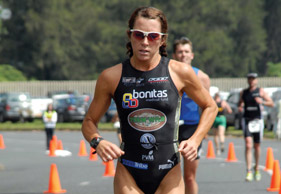TRI Training For Age Group Athletes
This is the second in our triathlon training and racing series. Not sure if this applies to you? Well, this article is directed at the average competitive age group athlete, not at the elite or age group athlete who will finish closer to the front of the field.
I am an average age group athlete myself and know that this group is comprised of the guys and girls who have full time careers, family and social commitments, as well as other interests/hobbies. However, we enjoy doing triathlon and like to be reasonably competitive. This means balancing training with your other commitments and maximising the training that
you do.
The training programme discussed below is mainly geared towards the standard distance, but can also be used for half
Iron Man events with some small adjustments.
BASIC TRAINING PRINCIPLES
1. Number of training sessions: You need to train a minimum of two of each triathlon discipline per week, aiming at three. That means six to nine training sessions each week, which can add up to training twice on some days.
2 Weekly di.stance: Aim at four times the race distance in training each week, that is, swim 6km, run 40km and cycle 160km. This should take around 12 hours each week.
3. Rest and recovery: As with any form of training, rest is very important, however the nature of triathlon training allows one to do a different sport like swimming when the legs are tired from a long run or long cycle. The important thing to understand is that everybody reacts to training differently. So, when you are tired, take a day off and rest. Do not try to catch up any sessions. Simply slot back into the programme after your day off.
4. Specific training: With limited time and three disciplines to train for, each and every session should have a specific goal in terms of what the training session is aimed at, as well as the event that you are preparing for. As an example, a long endurance ride must be just that and not become a speed session. Conversely, a speed session should focus on speed and not how many kilometres you are logging. If your upcoming event has a hilly cycle, you need to train specifically for that. Know what you want to achieve with each session you do and note that this is very different to a recommendation that first time triathletes will receive.
THE TRAINING SESSIONS
Let’s split the training into the three disciplines that occur in the same order as the event, namely, swim, cycle, run. Your ideal target is to get three sessions of each discipline in each week.
Swim Sessions
Session 1
should focus on endurance, doing some longer intervals at a steady pace (400m to 1 000m) with a short rest in between each interval. You need to do a total of 2km during the session.
Session 2
should focus on your race pace over shorter intervals (50m to 300m). Do 50m to 100m at a slow pace between each interval. Try do 2km per session.
Session 3
should be a 1.5km to 2km ‘open water‘ swim in a dam. This session is to develop the skill of swimming in open water.
Always do this with other swimmers, using a wetsuit and in the summer months only.
Cycle Sessions
Once again, your ideal target should be three rides per week.
Ride 1
should be 40/50km of steady spinning.
Ride 2
should focus on speed work or race pace riding (total ride of about 40/50km with 20km at race pace).
Ride 3
should be a long one, twice your proposed race distance (80km to 90km of steady cycling, but including some hills).
Run Sessions
Run 1
should be a steady easy run of around 10km to 12km.
Run 2
should be a run of 8km to 10km including some tempo or fartlek, or even a 5km time trial.
Run 3
should be a long run, twice the race distance (20km steady including some hills).
HOW TO PUT IT ALL TOGETHER
The foundation for any endurance sport is the longer sessions to build a good base. Thus, the most important sessions are the long cycle and long run. Saturday and Sunday mornings are usually the best time to train, so use them to do the longer cycles and longer runs. Use Saturday afternoons for the open water swim (in summer time only).
A typical programme could be structured like this:
Monday Swim
Tuesday Run
Wednesday Morning cycle, lunchtime or evening swim
Thursday Run
Friday Morning cycle, lunchtime or evening swim
Saturday Run – long
Sunday Cycle – long
I prefer to alternate running and cycling and add the swim sessions where possible, such as in the evenings or after a run/cycle. You WILL miss some days, either to rest or because of work, family or social commitments. Do not try to catch up any lost training, but make sure you try to do the faster running and cycling sessions.
Does this programme work?
Yes, this programme definitely works. I have used it very successfully for the last few seasons, with some very good results. As an example, for the three months before this year’s
SA Triathlon Champs, I did 88 sessions in 90 days: seven per week. My weekly averages were: swim 5.5km, run 41km, cycle 120km per week for 13 weeks. This is as close to the magic formula as it gets! With this training, I managed a 2:20:00 standard triathlon and finished second in my age group at
SA Champs.


